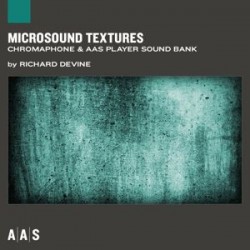 Canadian synthesis software developers Applied Acoustics Systems (AAS) has released the Microsound Textures sound bank for the Chromaphone creative percussion synthesizer and AAS Player plug-ins in collaboration with artist and sound designer Richard Devine.
Canadian synthesis software developers Applied Acoustics Systems (AAS) has released the Microsound Textures sound bank for the Chromaphone creative percussion synthesizer and AAS Player plug-ins in collaboration with artist and sound designer Richard Devine.
Microsound Textures joins Cardinals and KitNetix as the third title in Chromaphone’s Sound Bank Series expansion line.
AAS’ description of the sound bank:
“Microsound Textures is all about precision, details, subtlety, and complexity. Richard Devine’s idea was to use grain particles and tiny pulses to create rich and dense textures. In addition, the collection includes a wide variety of surprising and mysterious instruments ranging from light and delicate to dark and atonal. The 128 sounds are divided into five categories: Percussion, Sound Effects, Keys and Synths, Pads and Strings, and Textures and Ambience.”
Pricing and Availability. The Microsound Textures bank is available now as a download for $39. More information* is available on the AAS website.
*The instant download delivery package includes both a Chromaphone preset file and the free AAS Player plug-in. The AAS Player plug-in runs on both Windows and Mac OS X and supports the VST, Audio Unit, and RTAS plug-in formats.

AAS Website link above has “hhttp:” in the beginning of the link.
Fixed – thanks for the feedback!
“Richard Devine” has 13 letters, which when divided by 5 is 2 with a remainder of 3… 3+2= 5…. Tassman 5
“Microsound Textures” has 18 letters, which when divided by 5.5 is 3 with a remainder of 1.5 which when rounded up is 2… 3+2 again equals 5… Tassman 5? with a 5.5.2015 release date possibly? too predictable. Just release it 5 weeks from now
It all adds up to me.
I encourage everyone to consider a physical modeling synth. I use Sculpture in Logic and it really flexes your brain. It can be unpredictable, but once you grasp the idea of exciting a model instead of tweaking a Moogly signal chain, it becomes fun to play. Even the more tonal voices have inner movement traditional oscillators lack. It tends to be CPU-hungry (I often Freeze those tracks as I massage the piece) and some patches simply defy your happy ass to fix when they go wonky, but its powerful and ear-catching all the same. Check it out; like analog or sampling, its one of the unique pillars of sound generation methods.
Unquestionably believe that which you said. Your favorite justification seemed to be on the web the easiest thing to be aware of. I say to you, I certainly get irked while people consider worries that they plainly do not know about. You managed to hit the nail upon the top as well as defined out the whole thing without having side-effects , people could take a signal. Will probably be back to get more. Thanks